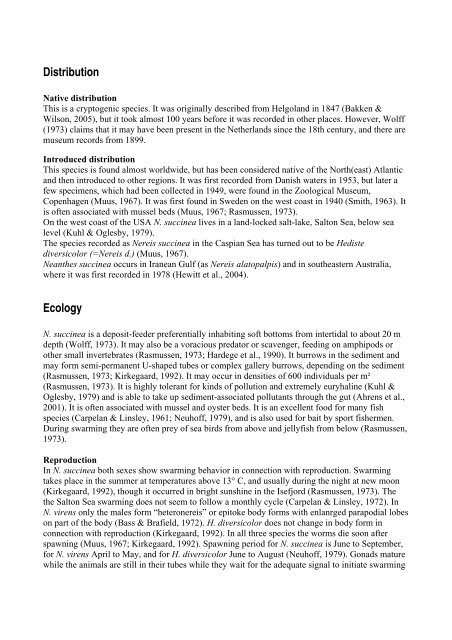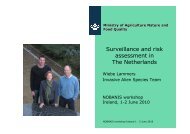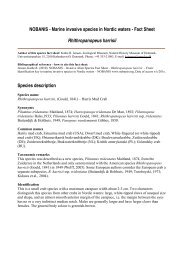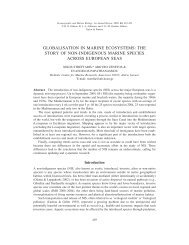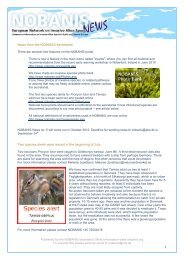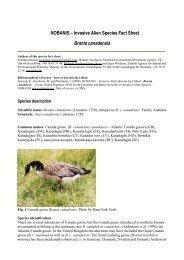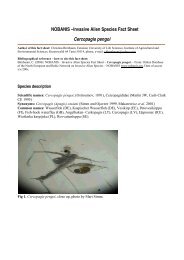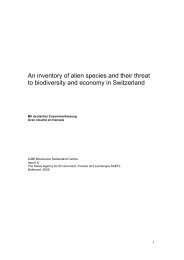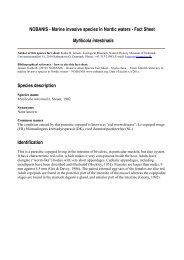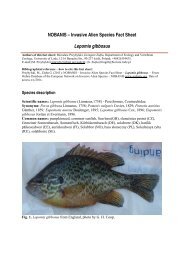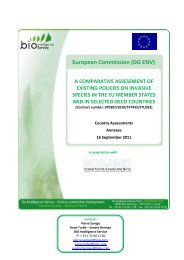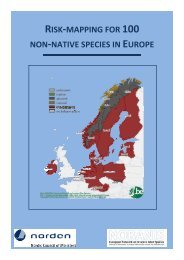NOBANIS - Marine invasive species in Nordic waters - Fact Sheet
NOBANIS - Marine invasive species in Nordic waters - Fact Sheet
NOBANIS - Marine invasive species in Nordic waters - Fact Sheet
You also want an ePaper? Increase the reach of your titles
YUMPU automatically turns print PDFs into web optimized ePapers that Google loves.
Distribution<br />
Native distribution<br />
This is a cryptogenic <strong>species</strong>. It was orig<strong>in</strong>ally described from Helgoland <strong>in</strong> 1847 (Bakken &<br />
Wilson, 2005), but it took almost 100 years before it was recorded <strong>in</strong> other places. However, Wolff<br />
(1973) claims that it may have been present <strong>in</strong> the Netherlands s<strong>in</strong>ce the 18th century, and there are<br />
museum records from 1899.<br />
Introduced distribution<br />
This <strong>species</strong> is found almost worldwide, but has been considered native of the North(east) Atlantic<br />
and then <strong>in</strong>troduced to other regions. It was first recorded from Danish <strong>waters</strong> <strong>in</strong> 1953, but later a<br />
few specimens, which had been collected <strong>in</strong> 1949, were found <strong>in</strong> the Zoological Museum,<br />
Copenhagen (Muus, 1967). It was first found <strong>in</strong> Sweden on the west coast <strong>in</strong> 1940 (Smith, 1963). It<br />
is often associated with mussel beds (Muus, 1967; Rasmussen, 1973).<br />
On the west coast of the USA N. succ<strong>in</strong>ea lives <strong>in</strong> a land-locked salt-lake, Salton Sea, below sea<br />
level (Kuhl & Oglesby, 1979).<br />
The <strong>species</strong> recorded as Nereis succ<strong>in</strong>ea <strong>in</strong> the Caspian Sea has turned out to be Hediste<br />
diversicolor (=Nereis d.) (Muus, 1967).<br />
Neanthes succ<strong>in</strong>ea occurs <strong>in</strong> Iranean Gulf (as Nereis alatopalpis) and <strong>in</strong> southeastern Australia,<br />
where it was first recorded <strong>in</strong> 1978 (Hewitt et al., 2004).<br />
Ecology<br />
N. succ<strong>in</strong>ea is a deposit-feeder preferentially <strong>in</strong>habit<strong>in</strong>g soft bottoms from <strong>in</strong>tertidal to about 20 m<br />
depth (Wolff, 1973). It may also be a voracious predator or scavenger, feed<strong>in</strong>g on amphipods or<br />
other small <strong>in</strong>vertebrates (Rasmussen, 1973; Hardege et al., 1990). It burrows <strong>in</strong> the sediment and<br />
may form semi-permanent U-shaped tubes or complex gallery burrows, depend<strong>in</strong>g on the sediment<br />
(Rasmussen, 1973; Kirkegaard, 1992). It may occur <strong>in</strong> densities of 600 <strong>in</strong>dividuals per m²<br />
(Rasmussen, 1973). It is highly tolerant for k<strong>in</strong>ds of pollution and extremely euryhal<strong>in</strong>e (Kuhl &<br />
Oglesby, 1979) and is able to take up sediment-associated pollutants through the gut (Ahrens et al.,<br />
2001). It is often associated with mussel and oyster beds. It is an excellent food for many fish<br />
<strong>species</strong> (Carpelan & L<strong>in</strong>sley, 1961; Neuhoff, 1979), and is also used for bait by sport fishermen.<br />
Dur<strong>in</strong>g swarm<strong>in</strong>g they are often prey of sea birds from above and jellyfish from below (Rasmussen,<br />
1973).<br />
Reproduction<br />
In N. succ<strong>in</strong>ea both sexes show swarm<strong>in</strong>g behavior <strong>in</strong> connection with reproduction. Swarm<strong>in</strong>g<br />
takes place <strong>in</strong> the summer at temperatures above 13° C, and usually dur<strong>in</strong>g the night at new moon<br />
(Kirkegaard, 1992), though it occurred <strong>in</strong> bright sunsh<strong>in</strong>e <strong>in</strong> the Isefjord (Rasmussen, 1973). The<br />
the Salton Sea swarm<strong>in</strong>g does not seem to follow a monthly cycle (Carpelan & L<strong>in</strong>sley, 1972). In<br />
N. virens only the males form “heteronereis” or epitoke body forms with enlanrged parapodial lobes<br />
on part of the body (Bass & Brafield, 1972). H. diversicolor does not change <strong>in</strong> body form <strong>in</strong><br />
connection with reproduction (Kirkegaard, 1992). In all three <strong>species</strong> the worms die soon after<br />
spawn<strong>in</strong>g (Muus, 1967; Kirkegaard, 1992). Spawn<strong>in</strong>g period for N. succ<strong>in</strong>ea is June to September,<br />
for N. virens April to May, and for H. diversicolor June to August (Neuhoff, 1979). Gonads mature<br />
while the animals are still <strong>in</strong> their tubes while they wait for the adequate signal to <strong>in</strong>itiate swarm<strong>in</strong>g


